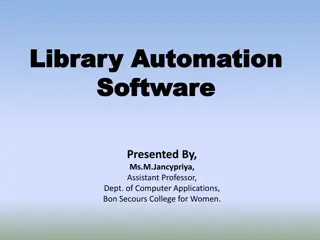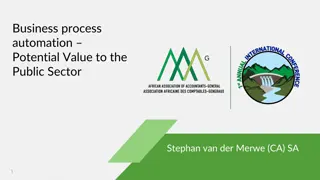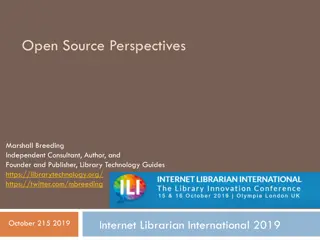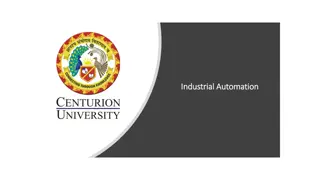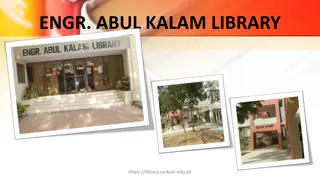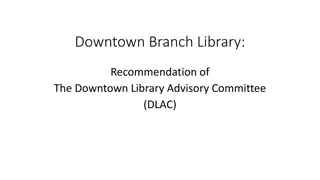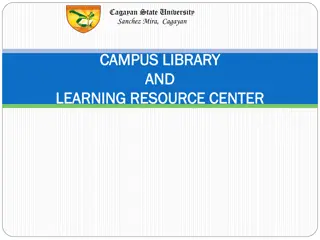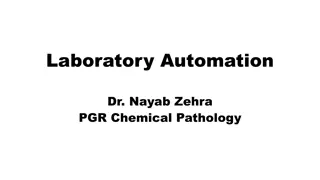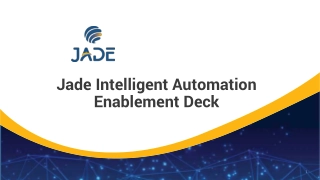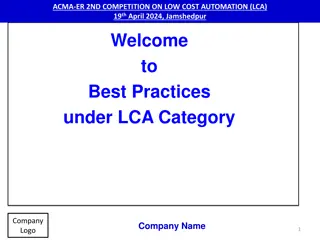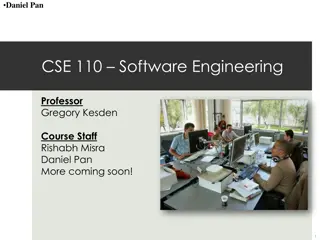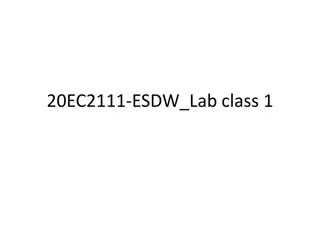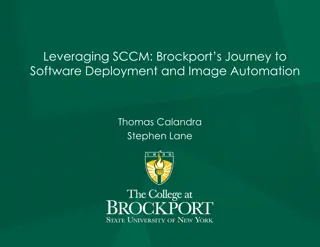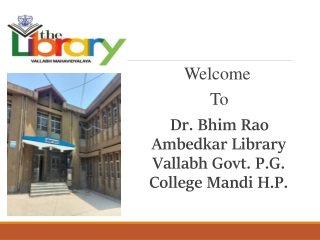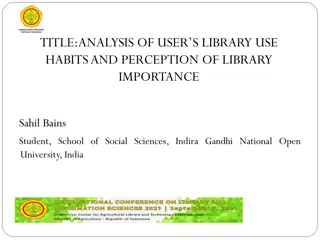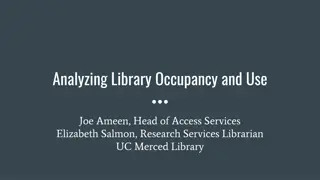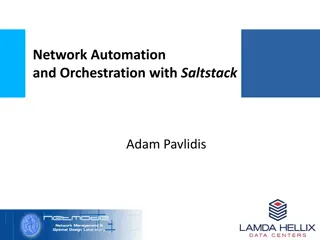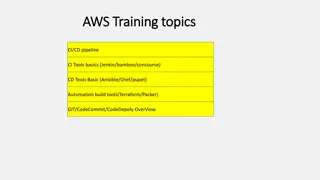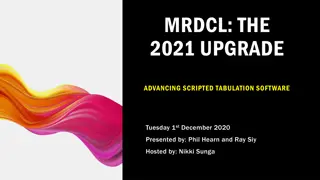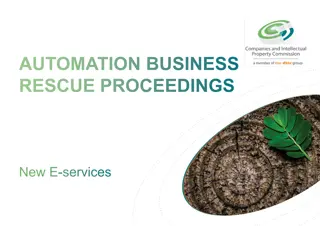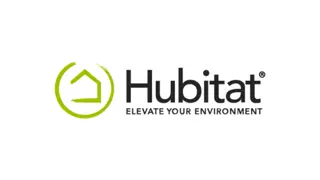Overview of Library Management Software and Automation
Understand the significance of library automation and management software in enhancing operational efficiency, providing new services, improving access to information, and facilitating communication among libraries. Learn about the functions, advantages, and the need for library automation outlined by Abdulkadir Ahmed Idris, Chief Librarian at the National Institute for Legislative Studies, Nigeria.
Download Presentation

Please find below an Image/Link to download the presentation.
The content on the website is provided AS IS for your information and personal use only. It may not be sold, licensed, or shared on other websites without obtaining consent from the author. Download presentation by click this link. If you encounter any issues during the download, it is possible that the publisher has removed the file from their server.
E N D
Presentation Transcript
Introduction to Library Management Software By Abdulkadir Ahmed Idris Chief Librarian National Institute for Legislative Studies, National Assembly Abuja Nigeria. 1 9/27/2024 Library Management Software By A A Idris
What is Library Automation ? 2 Library automation is the general term for information and communications technologies (ICT) that are used to replace manual systems in the library. The functions that may be automated are any or all of the following: acquisition, cataloging, public access (OPAC and Web PAC), indexing and abstracting, management, and reference circulation, serials 9/27/2024 Library Management Software By A A Idris
Need for Library Automation 3 Obtain increased operational efficiencies, Relieve professional staff from clerical chores so that they are available for user-oriented services, Improve the quality, speed and effectiveness of services, Improve access to remote users and other stakeholders, e.g., the general public, Improve access to resources on other networks and systems, including the Web. 9/27/2024 Library Management Software By A A Idris
Need for Library Automation Cont 4 Provide new services not hitherto possible, Improve the management of their physical and financial resources, Facilitate wider access to information for their clients, Facilitate wider dissemination of their information products and services, Enable their participation in resource-sharing library networks, and Enable rapid communication with other libraries (including outreach libraries) and professional peers. 9/27/2024 Library Management Software By A A Idris
What is Library Management System 5 A library management system, also known as an automated library system is software that has been developed to handle basic housekeeping functions of a library. Realizing the important role that the library management system will play in planning and implementing library automation projects, it is necessary to educate ourselves and know more about these systems. 9/27/2024 Library Management Software By A A Idris
What are the Advantages of an ILS ? 6 There is no duplication of records since the bibliographic database can be viewed before new records are encoded. Opportunities for errors are reduced since the record is entered only once. Library staff and patrons can view the status of the material from the OPAC or Web PAC. Library staff use the cataloguing, circulation, the OPAC and other services as needed. same master file for 9/27/2024 Library Management Software By A A Idris
General features of an ILS Functional modules basic modules - cataloging, OPAC and circulation - - Add on- acquisition, serial control, interlibrary loan (ILL), and Web OPAC Operating systems Database systems - Oracle, Informix, MS SQL, MS Access etc Network architecture 7 client-server architecture that uses TCP-IP to communicate across networks (LANs and WANs) User interface graphical user interface (GUI) is the norm for current systems because users find it easier to work with and it allows a wide range of tasks to be accomplished with a click of a mouse Library automation standards library industry standards such as MARC and Z39.50 9/27/2024 Library Management Software By A A Idris
Cataloging module 8 Used for the creation, storage, retrieval and management of bibliographic indexes. Defines the record format used in the database and provides for authority control author, subject headings etc. Usually there are two different interfaces for search and retrieval of the electronic catalog : For catalogers that allows them to maintain the library database (the main cataloging module), For users that allows them to search and display the results the Online Public Access Catalog (OPAC). records and/or 9/27/2024 Library Management Software By A A Idris
The OPAC 9 Cataloging activities using an ILS produce an electronic catalog. The means of access to the catalog for users which is limited to search and display is called an Online Public Access Catalog or OPAC. An OPAC is usually offered as an add-on module that is integral with the cataloging module. The specific search and display features of an OPAC vary from system to system. 9/27/2024 Library Management Software By A A Idris
Developments in OPACs 10 OPACs can also be linked to the circulation module so that users can find out from its OPAC record the status of an item (whether it is on loan, on-shelf, etc.) and loan information about it, as well as making a self- reservation and/or self-check-in/check-out maybe other features such as electronic resources on the Web or local databases) Recent developments in ICT have enabled libraries to publish their catalogs on the Web making them accessible locally (on site) and/or remotely through the Web as a Web OPAC. (and ILL, and links to 9/27/2024 Library Management Software By A A Idris
Web OPAC 11 PC s in LAN PC s connected to Internet Web server Bibliographic database OPAC 9/27/2024 Library Management Software By A A Idris
Circulation Module 12 Handles circulation activities such as: lending, return, renewal, and place on hold. Manages library materials - circulation type, location and status; patron database - patron type, profiles, privileges; and other transactions such as computation and payment of overdue fines, lost books, etc. May have added value functions like: import, export, and backup and restore functions for the databases; inventory; report generation; and support for MARC, Z39.50, ILL standards. May support integration with security systems that complement the self-check-in and checkout features of the circulation module. 9/27/2024 Library Management Software By A A Idris
Acquisitions module 13 Automates ordering, receiving, claiming materials from suppliers, and returns, and cancellations of materials Used to maintain statistics, and in some cases manage accounting activities. Acquisition can be done online if system is linked to an external network. the acquisition process - 9/27/2024 Library Management Software By A A Idris
Serials Control Module 14 Manages placing, canceling, claiming of orders; returning defective, unwanted and unordered material; and accounting information Provides a system for recording issues and keeping track of undelivered generating claim reports. May permit serial ordering online. and statistical issues by 9/27/2024 Library Management Software By A A Idris
Interlibrary Loan Module 15 Provides staff with an information management system for interlibrary loan transactions. This includes automatic monitoring of loans and accounts, making claims, putting holds on materials being borrowed, etc. Can also monitor the library's ILL activities, e.g. the number of items borrowed by individual clients, from where, for whom, etc. This module is seldom required except by libraries with very heavy ILL transactions. 9/27/2024 Library Management Software By A A Idris
Add-on Module 16 Usually offer additional functions and features as optional to the basic functions or as an integral part of a module. Examples are report generation, inventory, short loan transactions, import / export of records from / to MARC formats, Web OPAC, Z39.50 client and/or server services, and security systems linked to or integrated with the cataloging / circulation module. 9/27/2024 Library Management Software By A A Idris
Library automation standards 17 The standards adopted by the library industry and community that facilitate data interchange between libraries and institutions, and which are supported by most systems are Readable Cataloguing) standards and Z39.50, the information search and retrieve protocol standard. MARC (Machine 9/27/2024 Library Management Software By A A Idris
What is MARC 18 The Machine-Readable Cataloging (MARC) formats are standards representation of bibliographic and related information for books and other library materials in machine-readable communication to and from other computers. MARC 21 is the new standard for MARC. For more information about the MARC 21 standard visit the following site: http://lcweb.loc.gov/marc/marc.html used for the form and their 9/27/2024 Library Management Software By A A Idris
Need for MARC 19 The MARC standard allows libraries to share bibliographic resources with other libraries that also use it. It also enables libraries to easily migrate to commercially available library automation systems, a majority of which support only the MARC standard. A bibliographic record in MARC format will allow the application system or library automation system to: format the information correctly for printing a set of catalog cards or for displaying the information on a computer screen. search for and retrieve certain types of information within specific fields. display lists of items as required by the search. 9/27/2024 Library Management Software By A A Idris
What is Z39.50 Protocol 20 Z39.50 is generally defined as the information search and retrieve protocol standard used primarily by library and information related systems. The standard specifies a client/server-based protocol for searching and retrieving information from remote databases simultaneously using a single interface. 9/27/2024 Library Management Software By A A Idris
A library with an integrated library system 21 Reference OPAC Cataloging File Server: Database Circulation Serials Management Acquisition 9/27/2024 Library Management Software By A A Idris
Examples of ILS Software 22 Open source integrated library Open management system, are open and free software's. They can be used freely without having to pay license fees to its developers. Most exists under a standard license agreement that defines the terms of use. The most common is the General Public License (GPL), which specifies that the software can be used, modified, and distributed for free. eg. Evergreen, KOHA, OPALS, NEWGENLIB, OPENBIBLIO, BiblioteQ Etc. Source ILS: SOPAC, SENAYAN and 9/27/2024 Library Management Software By A A Idris
Cont 23 Proprietary ILS Software s: They are commercially oriented, they are developed by different companies. Proprietary software is closed, the source code is closely guarded by the vendor. eg. Alexandria, Librarian, Liberty, Exlibri, voyager, Genesis G3, Lib-portal, sirsi-dynix, Virture, Libman, Resource mate etc. fee based product 9/27/2024 Library Management Software By A A Idris
24 Questions and Comments Thank you for Listening! 9/27/2024 Library Management Software By A A Idris



